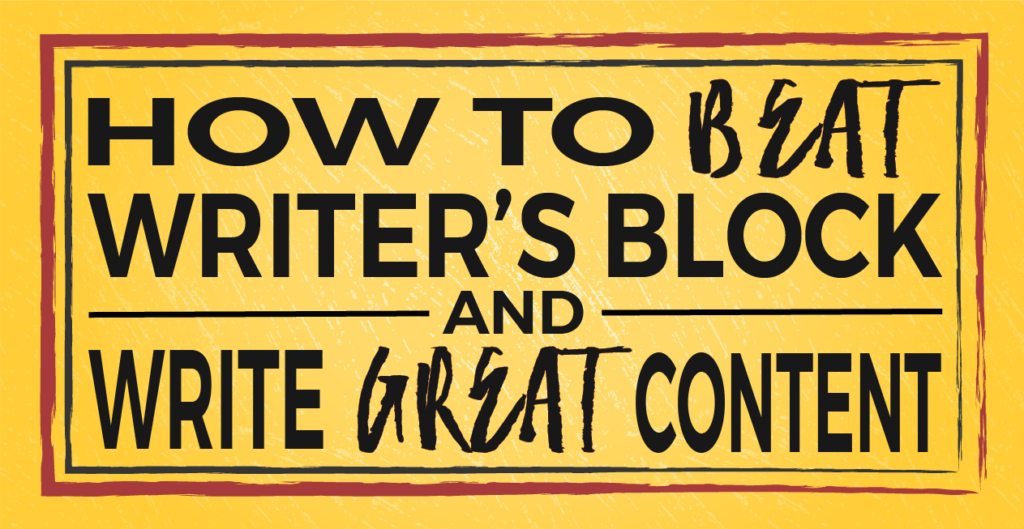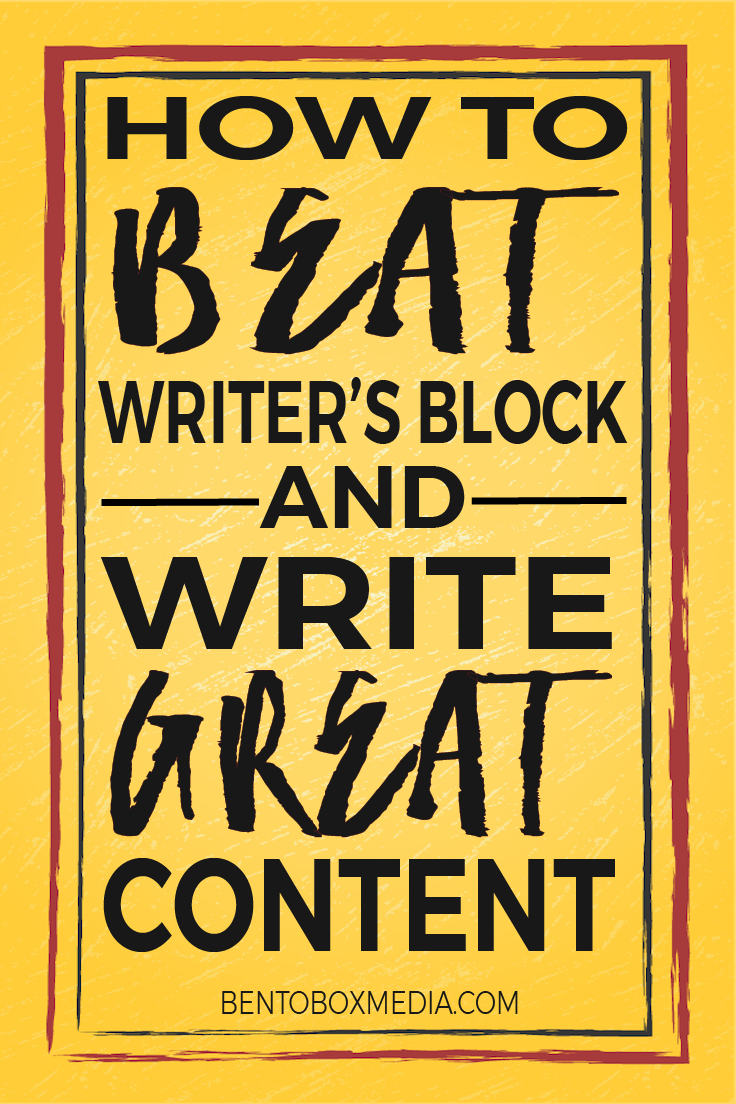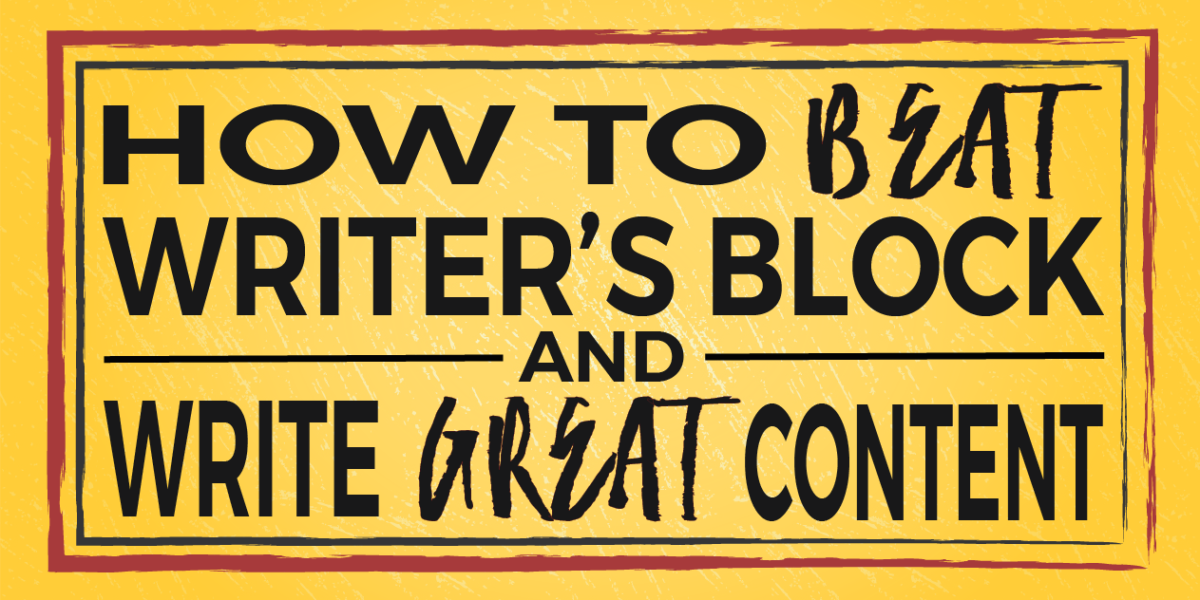
Do you need to write, but have no idea where or how to begin? Do you sometimes find yourself paralyzed by the blank, white screen or overwhelmed by the enormity of whatever you need to produce? Don’t stress. Every writer suffers writer’s block on occasion. The trick is to recognize what’s triggered your inability to write at the moment, and then take the steps to overcome it.
I’ve written professionally for more than two decades, and writer’s block still afflicts me on occasion. It can be extremely maddening and frustrating, but I’ve learned to embrace it because it’s really just part of the creative process.
In this blog post, I will share with you my foolproof ways to defeat writer’s block and get into the writing zone – you know, that amazing feeling where your creative juices are flowing, your writing becomes practically effortless and everything you are producing is brilliant.
And it’s OK if your first draft is not actually brilliant. The important thing is that you feel it’s brilliant. You can always improve it later in your second draft, which I will get into later.
Preparing to Write
The writing process begins before you even sit in front of your keyboard. There is prep work involved. You shouldn’t start with a blank slate. That can mean several things:
- Do research. If you’re not knowledgeable about the topic you are writing about, get that expertise by interviewing the experts with the promise that you will quote them and give them credit. Do online research and find source material that will help you write your content, such as statistics from a survey or poll. Also, see what others have written on the subject. I don’t mean plagiarize. I mean that if you see other people’s approaches, it can help you come up with ideas and new, innovative approaches to writing your content. For example, if you are writing a LinkedIn profile, a blog post or even an Instagram post to announce a special event or sale for your business, you can see examples of how other people have done it and draw inspiration from the ones you think have done theirs exceptionally well. It fosters creativity. If you are new to writing, I have one caveat. While this exercise can inspire you, there’s a chance it might send you into the other direction, a downward spiral of self-doubt where you think, “Why should I even bother writing about this? It’s been written in-depth countless times, better than I could do!” That can cause the worst writer’s block of all. You essentially convince yourself that you can’t write what you set out to write about. My answer to that: have confidence in yourself. With whatever topic you plan to write about, whether it’s healthy eating, gardening best practices or fixing cars, there is a high probability that you are not the first person to ever write about that topic or issue. There may be tens or sometimes hundreds of news articles and blog posts out there. But, so what. Don’t let that dissuade you. If you are passionate about something and want to write about it, go for it. First, your target audience may not even see that other piece of content, but they may see yours – because they are customers of yours because they follow you on social media and your social media voice resonates with them and a whole host of other reasons. And second, you have your own unique perspective and experiences, so use that to create something original and give your own spin, your own insights on the subject. Give your blog post a different twist, a different angle, a different nuance that makes yours unique. When I write, I sometimes quickly glance at what others have previously done, including the competition. I do it because I don’t want to create something that’s the same. It allows me to make sure I write something that’s better and provides added value.
- Brainstorm and write an outline. If you are knowledgeable about the issue you are writing about, then all the better. Combine your own expertise and some research, and you are almost ready to start writing. Once you are done with research, review all the material that you’ve compiled. Then brainstorm and jot down your ideas before you start writing. When you brainstorm, you don’t have to be at your desk. You can go for a walk, hit the gym or sit outside on your porch – whatever favorite leisure activity you have that is conducive to clearing your mind and brainstorming. Sometimes when I’m about to write, I do laundry. Yes, I’m serious. I find that doing laundry – putting a load into the wash or folding clean clothes – gives me the time to brainstorm and think about how I will approach writing a project. When you brainstorm, think about how you would start your writing project. Should your first few paragraphs be straightforward and to the point? Or should you start with an anecdote? Think about the main points you want to address and how you would transition from each main point. Next, write an outline to help you organize your thoughts. Your outline is your roadmap to follow as you write, from the beginning, middle to end. Write a headline as well. The headline tells the reader what they will get from reading your content, and for you, it serves as the mission statement for the content. You can refer to both your outline and headline as many times as you need to remind yourself of the purpose and goals of the content, and they can help you stay focused on the task at hand. You can make the outline as detailed as you need it to be. It depends on your style. You may need to write a comprehensive outline that lays out all the sections with the points you want to make in each paragraph. Or, if you’re like me, you can write a short outline like I did when I began writing this blog post.I went to the gym to brainstorm. While on the cardio machine, I came up with eight ideas and steps on how to overcome writer’s block and produce great content, and each time I came up with an idea, I typed it into the notes app on my iPhone.When I sat down to write, I looked at the list and added a few more ideas. It was not a detailed outline, but I don’t it to be. I prefer to write freely and come up with ideas and write what comes naturally to mind as I finish each sentence and paragraph. But that’s just my personal style. Do what works best for you – and what you are comfortable with. As you begin to write, use the outline as a guide and to keep you on track. But don’t be rigid. Be open to making adjustments. A point you initially planned to make in the third paragraph might work better in the ninth paragraph, for example.
Getting into the Writing Groove
- Write the first draft. Remember, the first draft is not the final draft, so just start writing and refine and perfect it later. Early in my career, when I wrote a news story for daily newspapers or wrote breaking news stories online for tech websites, I’d have to report and write a story fast – sometimes within 30 minutes or an hour. And my first draft was the final draft. But chances are you are not dealing with that kind of journalistic deadline pressure. So your first draft doesn’t have to be perfect, so don’t put that pressure on yourself. The important thing is to get the key points down. Being “good enough” is good enough for the first draft. Then you can revise, tweak and improve your copy in your second draft. Once you finish your first draft, take a break and let it simmer. Give it 30 minutes, a few hours or the next day. And then come back with a fresh look at what you’ve written, clean it up and make it better. Improve transition sentences. Analyze your verbs and replace passive tense with active tense. Remember, good writing is re-writing.
- Eliminate distractions. Are you working from home and the kids are making a racket? Or are you in a loud office? You can tell your children to pipe down, but you can’t do that to your coworkers. In those cases, put your earphones on and play music. Or take your notebook computer and work out on the patio or find an empty conference room to work in. And if your workplace is telecommuting friendly, just leave the office and go home and work. I work from home and have a home office. But sometimes there are distractions. Gardeners with their leaf blowers making a racket. Neighbors embarking on their next great home improvement project and that means coping with non-stop hammering and the screeching sounds of a circular saw cutting through wood. In those cases, I open the Apple Music app and listen to music. Or turn on the fan in my room. The white noise helps drown out the noise. These are a few suggestions to help you eliminate distractions. If all else fails, you can always head to a library or a nearby café with Wi-Fi and do your writing there.
- If you don’t have a real deadline, give yourself an artificial deadline. I procrastinate if I don’t have a deadline. In fact, it was three days after I brainstormed at the gym, that I had time to sit down to write this blog post. It’s Sunday as I type this. It’s a gorgeous day outside. There are many things I wish I could be doing outside, but writing this blog post is important. For the first hour, I was unfocused. I literally spent an hour getting caffeinated (that’s good for writing, at least for me). But I used that hour to also text with friends, read news online and watch music videos from 1980s one-hit wonders on YouTube.I was unfocused because I didn’t give myself a deadline. But at 2 p.m., I realized I needed to run errands at 4 p.m., so I gave myself a deadline and started to write. And now I’m in the groove. Give yourself a deadline and block out the time on your calendar. Trust me, it will help keep you focused and on track.
- If you’re stuck on one part, go back to it later and start work on another section. As a journalist, I always want to write the perfect lead – the first sentence or first few sentences of a story that hooks the reader in and makes the reader want to continue to read on.I’ve talked to many other journalists about this. Sometimes we come up with the perfect lead immediately and the rest of the story flows. But sometimes you get stuck. I’ve agonized over my lead for half an hour or more, trying to write the perfect lead. A former co-worker once gave me the best advice on how to handle that. Just write a lead – any lead – as a placeholder. And write the rest of the story. And then go back later to fix the lead later if you have to. That goes for any part of the story. You don’t have to write from top to bottom. If you’re stuck, write the bottom first or the middle first.
- To remain creative and productive, take regular breaks. Once you reach a writing milestone, like finishing a section or reaching the halfway mark of a 2,000-word story, reward yourself. Get a snack. Get another cup of coffee. Turn on the TV or check social media for a few minutes. Take a walk around the neighborhood or even take a shower to rejuvenate yourself. If you are tired or dragging, you won’t be creative. Take a short nap if you need to. That can refresh you and give you the boost you need to reach the finish line. And if the writer’s block is really bad, then….
- Talk to another person. If you are stuck, then talk it out with someone – a colleague, a friend, your significant other. They can commiserate with you, help you brainstorm and give you ideas to get unstuck. They can review what you’ve written already and give you feedback. And they can surprise you and tell you that you are on the right track.
- Get up and do something else. Do the dishes or the laundry. Shoot some hoops. Or if you golf, go to the driving range and hit some golf balls. Do something else, and while you do it, brainstorm and figure your way out of your current rut.
- If all else fails, free write. Remember in grade school when your English teacher told you to write whatever thoughts came to your mind and not worry about grammar and punctuation. Yeah, do that.It doesn’t have to be in complete sentences. Once you get all your thoughts from your outline down, the meat is all there. It’s messy, but you have a raw first draft. Be proud of that. And then go back to the top of the document and review it, and as you do, clean it up and revise where needed.
Bust through your writer’s block with the above tips and before you know it, you’ll have yourself a clean, well-written draft that you can be proud of.
 AUTHOR: Wylie Wong
AUTHOR: Wylie Wong
Wylie Wong is a seasoned journalist, author, writer and co-founder of BentoBox Media where he helps clients with content marketing, as well as writing magazine articles, breaking news stories, blog posts, website content and much more.
If you found this article helpful and valuable, we would greatly appreciate it if you share it with your tribe, friends, and followers.







Leave a Reply